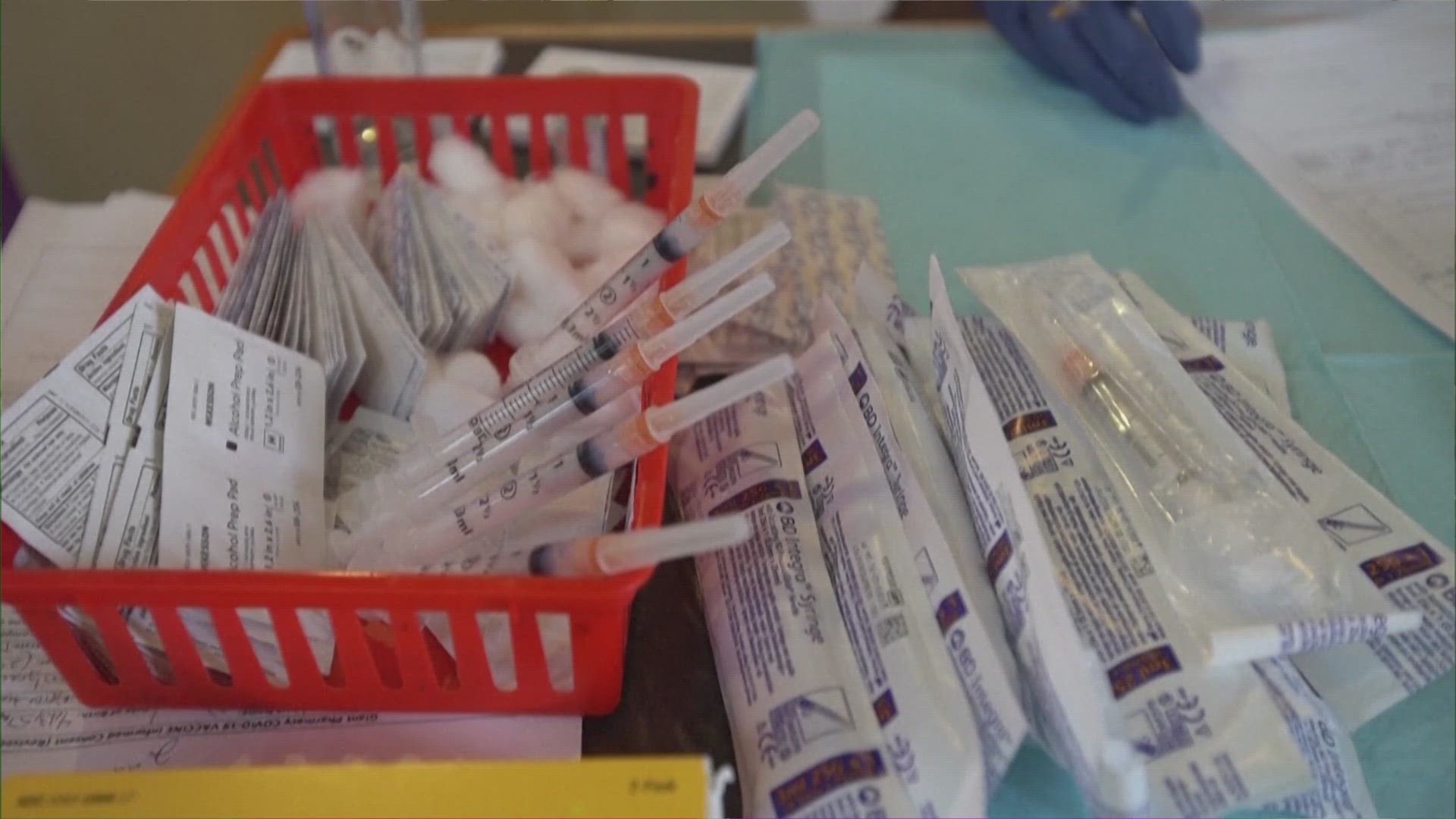SAN ANTONIO — We're tracking the latest numbers from the coronavirus pandemic in San Antonio and across Texas. Here are the latest numbers reported by Bexar and surrounding counties:
- Bexar County: 298 new cases were reported Tuesday, bringing the total number of cases for the county to 66,529. No new deaths were reported; the death toll remains at 1,260.
- Comal County: The county reported 24 new COVID-19 cases Tuesday morning as well as five backlogged cases added to county totals. No new virus-related deaths were reported. There have been a total of 3,825 reported cases of COVID-19 in the county – including 2,904 lab-confirmed cases – while 120 county residents have died. County officials say there are 128 active coronavirus cases, and 3,577 residents are considered recovered.
- Hays County: Officials in Hays County on Tuesday reported 55 new cases in the county and one additional virus-related death. As of Tuesday, there are a total of 6,231 lab-confirmed cases in the county (349 of which are active), while the death toll rose to 89. 5,793 residents have recovered from the virus.
How Bexar County is trending
We've tracked how many coronavirus cases have been confirmed in Bexar County from the time officials began reporting cases in March 2020. The graphic below shows the number of cases since June and charts those daily case numbers along a 7-day moving average to provide a more accurate picture of the overall coronavirus case curve in our area and the direction we're trending amid the pandemic.
On Tuesday, San Antonio Mayor Ron Nirenberg reported an additional 298 novel coronavirus cases for Bexar County. There have been at least 66,529 COVID-19 infections in our area during the ongoing pandemic.
The death toll in Bexar County remained at 1,260 after Nirenberg reported no new deaths from COVID-19 complications.


Hospitalization figures made a slight uptick on Tuesday, with a current total of 240 patients in local hospitals, a rise of seven since Monday. The number of patients using ventilators (46) and the number of patients in intensive care (104) also increased Tuesday.


Monday, Mayor Nirenberg noted two key risk indicators that were trending in the wrong direction in the last week. Bexar County saw an increase in cases over the last 14 days that started in mid-October. The county's positivity rate jumped almost a full percentage point in the last week, to 7.7%. Bexar County remains in the "moderate" zone of Metro Health's COVID-19 risk level indicator.
Coronavirus in Texas
The number of Texans who have tested positive for the coronavirus since the pandemic began grew by 7,516 on Tuesday, according to the Texas Department of State Health Services.
7,215 of those are new diagnoses over the last 24 hours, while another 301 cases stem from a number of backlogs in several counties. More details can be found at the top of this page.
As of Tuesday, at least 916,773 Texans have contracted COVID-19.


State health authorities also reported 97 additional virus-related deaths on Tuesday. At least 18,194 Texans have passed away from COVID-19 complications.
5,936 Texans are currently receiving treatment for COVID-19 symptoms—166 more patients overall than on Monday. The state added 89 available ICU beds, bringing that number back over 1,000.
October saw a reversal of the previous two months' positive trends pertaining to the COVID-19 situation in Texas, including lower hospital admissions and case numbers. October ended with 79% more current hospitalizations than on Oct. 1. Health officials warn that the state is currently in another surge. Experts attribute the spike in COVID-19 numbers to "pandemic fatigue."
The state estimates that 792,286 Texans have recovered, while 108,522 Texans remain ill with COVID-19.
Meanwhile, the latest update from the Texas Education Agency showed that there have been 26,127 cumulative cases among staff and students across the state through Oct. 25. More information can be found here.
The TEA releases new data on school cases every Thursday.
Latest Coronavirus Headlines
- City of San Antonio offers several options to help people struggling during the pandemic
- Does weather affect the spread of the coronavirus outside?
- Volunteers needed for final phase of COVID-19 vaccine testing in Houston
- NFL: Masks mandatory at halftime, before and after games
- Cowboys reportedly place quarterback Andy Dalton on reserve/COVID-19 list
- Large crowds spotted on Sixth Street in Downtown Austin on Halloween night
Coronavirus symptoms
The symptoms of coronavirus can be similar to the flu or a bad cold. Symptoms include fever or chills, cough, shortness of breath or difficulty breathing, fatigue, muscle or body aches, headache, new loss of taste or smell sore throat, congestion or runny nose, nausea or vomiting and diarrhea, according to the Centers for Disease Control.
Most healthy people will have mild symptoms. A study of more than 72,000 patients by the Centers for Disease Control in China showed 80 percent of the cases there were mild.
But infections can cause pneumonia, severe acute respiratory syndrome, kidney failure, and even death, according to the World Health Organization. Older people with underlying health conditions are most at risk.
But infections can cause pneumonia, severe acute respiratory syndrome, kidney failure, and even death, according to the World Health Organization. Older people with underlying health conditions are most at risk.
Experts determined there was consistent evidence these conditions increase a person's risk, regardless of age:
- Chronic kidney disease
- COPD (chronic obstructive pulmonary disease)
- Obesity (BMI of 30 or higher)
- Immunocompromised state (weakened immune system) from solid organ transplant
- Serious heart conditions, such as heart failure, coronary artery disease, or cardiomyopathies
- Sickle cell disease
- Type 2 diabetes
The CDC believes symptoms may appear anywhere from two to 14 days after being exposed.
Human coronaviruses are usually spread...
- Between people who are in close contact with one another (within about 6 feet).
- Through respiratory droplets produced when an infected person coughs, sneezes or talks. These droplets can land in the mouths or noses of people who are nearby or possibly be inhaled into the lungs.
- Some recent studies have suggested that COVID-19 may be spread by people who are not showing symptoms.
Help stop the spread of coronavirus
- Stay home when you are sick.
- Eat and sleep separately from your family members
- Use different utensils and dishes
- Cover your cough or sneeze with your arm, not your hand.
- If you use a tissue, throw it in the trash.




